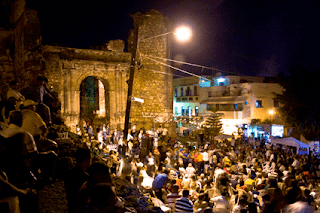Songlines, November / December 2012
Ed Stocker discovers what locals in the capital of the Dominican Republic do to counteract Sunday night blues – they listen and dance to son and merengu
Santo Domingo is the oldest European city in the Americas, founded in 1496, and a beautiful time warp of gently crumbling colonial facades and elaborate churches that draws immediate comparisons with Havana (Andy García shot his Cuba-set 2005 film The Lost City here).
But on a humid Sunday, as the Caribbean sun is setting and San Francisco – a former monastery built in the 16th century – is illuminated with lights, the crowd’s attention is firmly fixed not on the ruins, but on the group of old timers, performing classic Dominican and Cuban-influenced son, salsa and bolero, alongside merengue.
The place is buzzing. Onstage the five leaders of Grupo Bonyé are lined up in front of microphones, several bashing out a rhythm on hand percussion. To the side is the rest of the group, 11 more musicians including Carlos Gómez on timbales, Nelson Edy on piano, Vinicio Guerrero (aka ‘The Rabbit’) on congas and Andrés Merejo on tenor saxophone.
The group, who started their open-air concerts in 2008, fire out the classics. They’re a well-drilled unit, for sure, but also allow themselves space to improvise and interact with the crowd. The front line of singers are in the groove – swaying their hips to the Latin rhythms and shimmying backwards and forwards on the stage in unison, wide grins on their faces.
The band takes its name from José María Guerrero (known as ‘Bonyé’), one half of a famous son dancing couple that set the world ablaze in 2002 when they won an international dance competition despite their advanced years. Grupo Bonyé’s repertoire includes several son, such as the hugely popular ‘Lágrimas Negras’ that causes a ripple of appreciative applause. Other crowd pleasers are the traditional merengue ‘Los Algodones’ and Bonyé’s own composition, an ode to their hometown, ‘Santo Domingo es Alegría’ (Santo Domingo is Happiness).Judging by the faces of the some 3,000 people in attendance, Bonyé are doing something right. The Sunday night session is a place to unwind and have fun. It’s a place to keep the weekend going as long as humanly possible and forget about what Monday may bring. It’s a place to enjoy an ice-cold Presidente beer and a deep-fried cheese empanada. It’s a place to sit at one of the plastic tables and marvel at the spectacle (or take five minutes out to catch up on the baseball score – the country’s other national obsession – in one of the nearby bars).
But the night isn’t just for watching – it’s about taking part. In front of the stage is a makeshift dance floor where couples quickly assemble and melt away when their favourite tune starts and finishes. This is an event that spans generations, a place packed with families and friends mixing freely.
“There are people here of all ages,” band director Félix Báez tells me after the show, “kids, young people, adults and older generations. Thanks to what we’ve been doing, other son groups that had stopped playing have now reformed. They’re back again.
“One of our main focuses as a group has been to rescue traditional music from a generational abyss caused by young people listening to reggaeton and modern music. We’ve shown the Dominican Republic youth what this old music is all about and our project has been really successful. Young people here at San Francisco are now dancing son and traditional merengue – and they like the boleros too.”
Perhaps the most surprising moment of the night is when the music grinds to a halt and the band pauses to address the crowd. It’s a short interlude, evoking the heroes that have died protecting the Dominican Republic from independence from Haiti in 1844 to present day.
Dominicans are clearly a proud people – proud of their coastline, their monuments and their history. And music may just be the best way they express it – as long as there’s a decent helping of alegría in there, too, of course.

